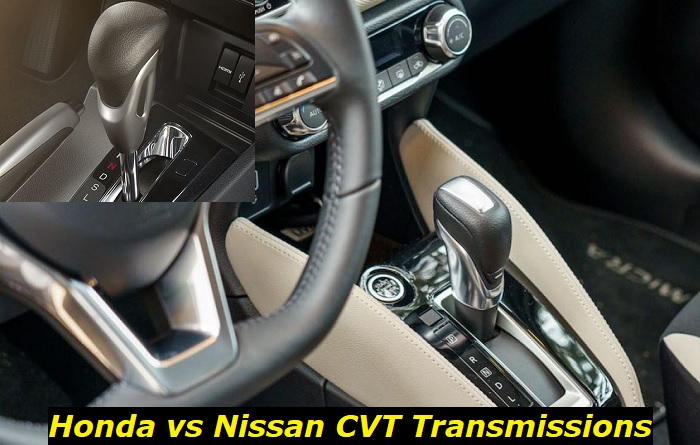A continuously variable transmission, or CVT transmission for brevity, is a type of automatic transmission that uses a series of pulleys and belts to deliver power from the engine to the wheels. CVT transmissions are considered to be more efficient than traditional automatic transmissions, and they are seen to offer smoother, more precise shifting.
Honda CVT transmissions highlights
- Average lifespan:120,000-140,000 miles
- Reliability Score:Medium
- Prone to minor issues:Not much
- Price for repair after failure:Usually, no repair
- Price for replacement:$4,000-$6,000
- Availability of parts:Poor
- Common problems:noise, clunking, only reverse available, glitches, problems with control module.
Nissan CVT transmissions highlights
- Average lifespan:90,000-100,000 miles
- Reliability Score:Low
- Prone to minor issues:Yes
- Price for repair after failure:Usually, no repair
- Price for replacement:$4,000-$6,000
- Availability of parts:Poor
- Common problems:bad fluid leaks, shuddering, only reverse available, various noises, complete loss of power, slipping.

How CVT Transmission Works
The pulleys and belts in the CVT transmission are connected to a series of gears, which rotate at different speeds. As the engine speed increases, the pulleys and belts move to larger gears, providing more power to the wheels. When the engine speed decreases, the pulleys and belts move to smaller gears, reducing the amount of power delivered to the wheels.
CVT transmissions are more efficient than traditional automatic transmissions because they allow the engine to operate at its most efficient speed for a given road speed. They also offer smoother, more precise shifting (or better say no shifting at all) than traditional automatic transmissions. CVT transmissions are lighter and smaller than traditional automatic transmissions, too, making them ideal for use in small cars.
These transmissions offer better performance and fuel economy than traditional automatic transmissions. They allow the engine to operate at its most efficient speed for a given road speed, which results in better fuel economy. They provide smoother, more precise shifting than traditional automatic transmissions as well, which leads to improved performance.
CVT transmissions are becoming increasingly popular in small cars, and they are expected to become more common in larger vehicles. They offer many benefits over traditional automatic transmissions, and they are an important part of the future of automotive transmission technology.
Honda CVT vs Nissan CVT Longevity
Many things run parallel with Honda and Nissan. One is that both are giant multinational corporations originating from Japan. Second, they have more than half-a-century experience in developing cars. However, the same cannot be said about the quality of their products, and that includes their respective CVT transmissions.
- Honda CVT Transmission
Honda is known for its in-house CVT transmission. When it comes to benchmarking, the company's HR-V and Civic CVT transmission models have become a very reliable take-off point when assessing the CVT transmissions offered by other manufacturers.
The CVT transmission of Honda had its share of bashing over the years, however. That's mainly because the automaker entered the game way too earlier than its competitors. The Japanese company introduced the technology in its Civic HX in the mid-90s making it among the first in the industry to apply it in mass-produced models.
Being among the first to adopt the innovative approach in transmission engineering meant that there were still unforeseen problems with it. Therefore, a barrage of complaints came from users later on, and since then, the trauma has carried on to the later CVT models of the brand.
It should be noted, though, that the Honda CVT transmission has come a long way since its initial application. With that, a lot of the problems that have plagued its older series have already been ironed-out in the more modern versions.
It's for that fact that Honda has confidently developed its own CVT transmissions over the years. Although it still has its share of problems, the automaker seems to be quick to address them whenever possible.
When it comes to longevity, the more modern iteration of Honda's CVT transmission promises a mileage of at least 200,000 miles before requiring an overhaul or replacement. Of course, the numbers come with the premise that the vehicle carrying it is well-maintained.
- Nissan CVT Transmission
Nissan was also among the first to enter the CVT craze in the 90s. It came a couple of years earlier than Honda when it integrated the technology in its March/Micra model in 1992. Similarly, the early adoption of the system didn't come without plenty of hiccups.
After decades since the introduction of CVT transmission in its vehicles, one might expect Nissan to have provided a solution for the problems that came as a byproduct of its innovation.
It's sad to note though that many complaints hounding the brand still involve the same issues experienced by the owners of its CVT transmission's first-generation models, which certainly do not look well from a business standpoint. As a result, a lot of disgruntled Nissan owners may tell you to steer clear of vehicles equipped with them.
The alleged lack of action from Nissan to resolve its CVT transmission problems has also been the subject of several class-action lawsuits. Some of these have been settled amicably between Nissan and the complainants while others are still pending resolution.
Despite the settlement, Nissan has not admitted to any defects in the models covered by the lawsuits. Instead, the company reasoned out that it only agreed to settle with the concerned parties to avoid litigation costs stemming from years of court battles.
One of the likely reasons why Nissan is not as quick to address the problems plaguing its CVT transmission-equipped vehicles is due to the fact that it sources them from another party. At present, Nissan gets its CVT transmission from JATCO, a subsidiary of the company.
With that said, even the present versions of the Nissan CVT transmission, are not expected to last as long as Honda's. These have been notorious for requiring major repairs and even replacement before the 100,000-mile mark.
CVT Advantages and Disadvantages
As mentioned, the CVT transmission is a type of automatic transmission that uses a pulley and belt system to change gears. In general, this system can provide an infinite number of gear ratios, which makes it ideal for fuel-efficient driving. However, there are some disadvantages to using a CVT transmission, which include potential reliability issues and a lack of response when accelerating.
Let's take a closer look at both the advantages and disadvantages of the CVT transmissions from Honda and Nissan:
Advantages:
1. Fuel Efficiency
The main advantage of CVT transmissions is that they are very fuel efficient. This is because the transmission can find the optimal gear ratio for any given situation, which often results in lower engine RPMs and less fuel consumption. Honda has apparently almost perfected its CVT transmission over the years due to its long-time experience with its development and has successfully rolled it out in almost all of its new vehicles already.
2. Smooth Operation
CVT transmissions also offer a very smooth driving experience, as there are no gear changes to jarringly interrupt the flow of power. This can be a particularly appealing feature for those who do a lot of city driving. Honda rises to this occasion that's why it has been frequently used as a benchmark when comparing other alternatives.
3. Reduced Maintenance Costs
Since CVT transmissions have fewer moving parts than traditional automatic transmissions, they often require less maintenance and may have a longer lifespan. This can lead to reduced maintenance costs over the life of the vehicle. Honda prides itself on having longer service intervals for its CVT transmissions than other manufacturers. Likewise, its in-house production for its CVT transmission means it is easier to get replacement parts for it.
Disadvantages:
1. Potential Reliability Issues
One of the main disadvantages of CVT transmissions is that they have been known to be less reliable than traditional automatic transmissions. This is because CVT transmissions are often complex and have more potential failure points.
As a result, CVT transmissions may require more frequent repairs or replacement than traditional automatic transmissions. Although Honda has continuously addressed issues related to its CVT transmission, Nissan is a bit lagging in this department.
2. Lack of Response when Accelerating
Another potential downside to CVT transmissions is that they can sometimes lack the response that drivers want when accelerating. This is because the transmission may take a moment to find the correct gear ratio, which can result in a delay in power delivery. This can be frustrating for those who are looking for a quick and responsive driving experience. Nissan is particularly known for this issue.
3. Whirring Noises
Last but not least, an inherent downside of CVT transmission is its tendency to produce whirring noises. This can be unsettling to users who are not used to it. Honda users in particular have complained about their vehicles producing sounds that are louder than usual in their transmissions.
Conclusion
While it's true that Honda and Nissan have adopted the CVT transmission system in their vehicles almost at the same time, the former appears to be superior to the latter when it comes to this technology due to its dedication to continuously introducing developments into it. Therefore, when choosing between the two, the modern version of the Honda CVT transmission certainly comes as a better option.
About the authors
The CarAraC research team is composed of seasoned auto mechanics and automotive industry professionals, including individuals with advanced degrees and certifications in their field. Our team members boast prestigious credentials, reflecting their extensive knowledge and skills. These qualifications include: IMI: Institute of the Motor Industry, ASE-Certified Master Automobile Technicians; Coventry University, Graduate of MA in Automotive Journalism; Politecnico di Torino, Italy, MS Automotive Engineering; Ss. Cyril and Methodius University in Skopje, Mechanical University in Skopje; TOC Automotive College; DHA Suffa University, Department of Mechanical Engineering






Add comment